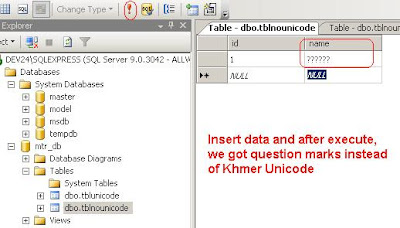Transact- SQL Syntax Conventions. In SQL Server, you can use CONVERT or CAST functions to convert a datetime value (DATETIME, DATETIMEdata types i.e.) to a string. Microsoft SQL Server - Stack. GILT FÜR: SQL Server Azure SQL-Datenbank Azure SQL Data Warehouse Parallel Data Warehouse APPLIES TO: SQL Server Azure SQL Database Azure SQL Data Warehouse Parallel Data Warehouse Diese Funktion wandelt einen int-ASCII-Code in einen Zeichenwert um.
Instea the operation truncates before the supplementary character. This function converts an int ASCII code to a.
W SQL jest wbudowanych wiele gotowych już funkcji, które ułatwiają nam życie. The ASCII number code to return the character for: Technical Details. It returns the character based on the NUMBER code. Funkcje CAST i CONVERT - zamiana typów danych w SQL na inny, różnice i możliwości zastosowania.
CHAR (code) Parameter Values. Darmowy kurs SQL Server online. ESCAPE character only if specified. A wildcard character is used to substitute one or more characters in a string.
Wildcard characters are used with the SQL LIKE operator.
The LIKE operator is used in a WHERE clause to search for a specified pattern in a column. This article explains the functionality and uses of the LEFT, RIGHT, SUBSTRING and CHARINDEX functions in SQL. This article will leave you with sound knowledge and understanding that you can take away and questions will be asked no more. The conversion of a char data type to a datetime data type resulted in an out-of-range datetime value.
I am using Sybase and I am doing a select which returns me a column called iftype, but its type is int and I need to convert into varchar. When I try to do the select without the convert function. Description of the illustration to _ char _date. SQL HOME SQL Intro SQL Syntax SQL Select SQL Select Distinct SQL Where SQL An Or, Not SQL Order By SQL Insert Into SQL Null Values SQL Update SQL Delete SQL Select Top SQL Min and Max SQL Count, Avg, Sum SQL Like SQL Wildcards SQL In SQL Between SQL Aliases SQL Joins SQL Inner Join SQL Left Join SQL Right Join SQL Full Join SQL Self Join SQL. YYYY-MM-DD HH24:MI:SS 으로 변경하는 방법이다.
Before we go ahead about these functions first I will introduce little bit about ASCII ASCII stands for American Standard Code for Information Interchange. To broaden the selections of a structured query language ( SQL -SELECT) statement, two wildcard characters, the percent sign ( ) and the underscore (_), can be used. The percent sign allows for the substitution of one or more characters in a field. Hello, with CharIndex you can get the position of slash, with SubString the part from position on to. More Information To begin with, the character date and time must be converted into the SQL Server datetime format.
If I can convert the databases element to a. Thanks for the help, but before I read the reply, I found another way to do it. If you ever need to find the ASCII code for a given character when using SQL Server, the T- SQL ASCII() function is probably what you need. The ASCII() function returns the ASCII code value of the leftmost character of a character expression.
Simply provide the character as an argument and SQL Server will return the ASCII value of that character (or the leftmost character in the string). Also, often times these bad characters are not known, say, in one of the recent posts the question was to filter all the rows where characters were greater than ASCII 127. SAS SQL function but an Oracle or MS SQL function. How to convert Unicode Data to ASCII and back in SQL server. ISO Character Set - SQL _Latin1_General_CP1_CI_AS) but it differs in how it implements other.
The search is NOT case-sensitive. In SQL Server, the TRIM() function is commonly used to remove leading and trailing whitespace from a string. It doesn’t have to be whitespace.
TRIM() is a T-SQL function that specifically removes the space character char(32) or other specified characters from the start or end of a string. SQL is a standard language for storing, manipulating and retrieving data in databases.

Brak komentarzy:
Prześlij komentarz
Uwaga: tylko uczestnik tego bloga może przesyłać komentarze.